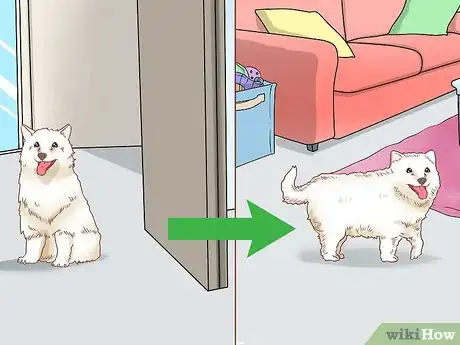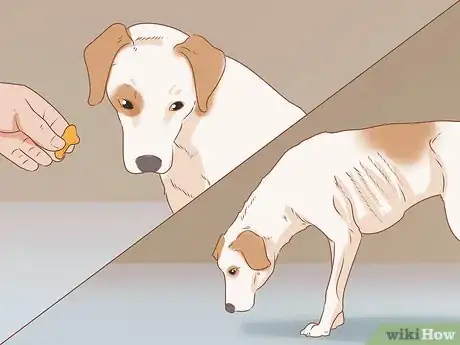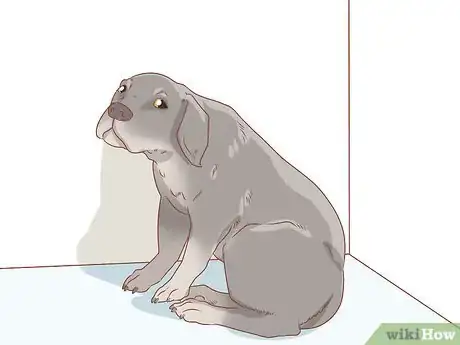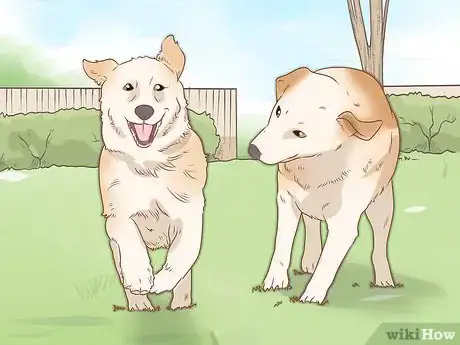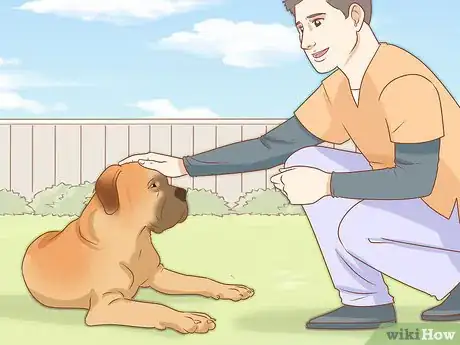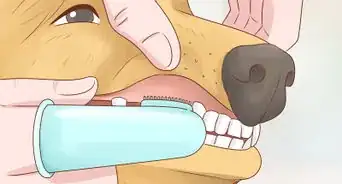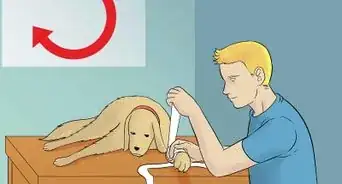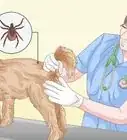This article was co-authored by Jaimie Scott. Jaimie Scott has been training dog owners as the Owner of Jaimie Scott Dog Training in Sacramento, California for the past 15 years. Jaimie meets clients for 1-on-1 training, group classes (owners only, no dogs), as well as live video classes. Jaimie has published videos, blog articles, and eBooks to share tips for training and his personalized insight into dog behavior. With a focus on training the owners, Jaimie believes that dogs need to know who’s in control at any given time in order to feel secure and be happy. Jaimie holds a BS in Mathematics and Computer Science from Pacific University.
There are 10 references cited in this article, which can be found at the bottom of the page.
wikiHow marks an article as reader-approved once it receives enough positive feedback. This article received 12 testimonials and 98% of readers who voted found it helpful, earning it our reader-approved status.
This article has been viewed 349,819 times.
Dogs can suffer from depression, just like humans. This depression usually comes about as a result of a change in routine, such as the loss of a companion, moving house or a new addition to the household. It manifests itself both through behavioral changes such as loss of energy, pacing, and lack of appetite, and through changes in body language like a drooping tail and ears. It is important that owners recognize the signs of canine depression, so that they can take steps to improve their dogs’ mental health.
Some advice from veterinarian, Pippa Elliott MRCVS: "Dogs do get depressed, for sure. However, never jump to conclusions. If your dog is acting out of character, first rule out a health problem by a trip to the vet, before assuming the problem is low mood."
Steps
Identifying Changes in Behavior
-
1Think about whether your dog has become withdrawn. Most healthy, happy dogs are highly sociable creatures. If your dog is not greeting you as excitedly when you come home – less of a tail wag, less energy and movement – or loses interest in activities they once enjoyed, they may be depressed.
- Instead of running to the door to greet visitors, a depressed dog may slink away and find an out-of-the-way corner to curl up and go to sleep.
- Be particularly concerned if your dog hides from you. Dogs that hide are usually injured, sick, or depressed.[1]
- On the other hand, depressed dogs sometimes follow their owners around everywhere they go, yet show no desire to interact.
-
2Look for a change from active to inactive. Happy dogs have seemingly endless energy. For every mile you walk, he goes four – out-and-back, and out-and-back again. They nag you to throw the ball repeatedly, and your arm grows tired before their enthusiasm runs out.
- However, when depressed, your dog no longer pricks their ears up when you get their lead, and instead of charging off across the park, they trudge head-down at your heel. When you stop to talk to friends, they may sit, or even lie down.
- This change from active and energetic to inactive and lethargic may indicate depression.[2]
Advertisement -
3Watch for pacing. If your dog wanders from room to room and can’t find a place to settle down, they may be depressed.
-
4Observe any changes in your dog's sleeping patterns. All dogs sleep a lot, particularly when their owners are gone. However, you should be concerned if your dog continues sleeping when you get home, or if they stay curled up instead of coming to the window or door for things that once attracted them, like the mail carrier or a passing dog.[3]
-
5Note changes in your dog’s diet. Most dogs will eat less and lose weight when depressed. On the other hand, just like humans, some dogs may eat more as a form of comfort.[4] Watch for:
- Refusing treats that they once loved.
- Weight gain or weight loss.
-
6Consider whether destructive behavior or accidents in the house might be due to depression. Tearing up shoes or chewing on walls, books, furniture, or pillows are often signs of lack of exercise, which may lead to depression. Depressed dogs may also be more prone to have accidents in the house. Try not to be angry. Take them out more to ensure they have plenty of time to pee or poop outdoors.
-
7Watch out for aggression. If your dog begins to growl, snap, or otherwise act aggressively when you try to interact with them, this may be a sign of depression.[5]
Observing Your Dog's Body Language
-
1Pay attention to your dog’s eyes. Dogs squint, making their eyes appear smaller, when they are in pain, stressed, or depressed.[6] Depressed dogs may also be reluctant to make eye contact with anybody, even you.
- Of course, some dogs have "sad" eyes at the best of times, due to naturally droopy eyelids rather than depression, so exercise a little common sense when interpreting sad eyes as a sign of depression.
-
2Observe your dog for droopy or pulled back ears. Depressed dogs tend to display a lack of responsive ear movements to noises going on around them. For example, your dog may fail to prick up their ears at the sound of things that normally interest them, such as you calling their name, or their collar and lead being fetched prior to a walk.
-
3Watch for paw licking. Licking or chewing their paws is a comfort mechanism for dogs, and can be a sign of depression.[7]
-
4See if your dog hangs their head. Depressed dogs tend to keep their heads lowered when standing or sitting. When lying down your dog prefers to rest their chin on the ground, and rarely raises their head in response to activity going on around them.
-
5Monitor how your dog carries his tail. When a dog is depressed, the tail is held down or between the legs and doesn't wag as readily. When you encourage your dog to wag his tail, the motion is subdued and half-hearted. [8]
-
6Be aware of your dog's overall body position. Depressed dogs tend to stand in a passive way, with their heads down and tails lowered, barely reacting to encouragement. Your dog may give the impression of feeling sluggish, and will lack interest in what's going on around them.
-
7Watch for extra shedding. When dogs are stressed, they tend to shed much more heavily.[9] If you pet your dog and your hand comes away covered in hair, or if you are suddenly having to vacuum much more often, your dog may be depressed.
Knowing What to Do Next
-
1Ensure that your dog is not sick. If your dog is behaving in an unusual manner, it is wise to get them checked out by a vet. There is often a cross over in symptoms between depression and sickness, and it is not always easy to tell the difference because both sick and depressed dogs tend to be off their food, and are reluctant to exercise.[10]
-
2Understand what may have triggered the depression. A healthy dog is unlikely to become depressed for no reason, therefore it is helpful to know if a recent event has impacted your dog's mental well-being. Dogs are routine driven, so the most common trigger for canine depression is a change of routine.[11] Changes in routine that can trigger depression may include:
- Stress: In doggy terms stress includes anything that stops him from getting the attention he is used to.
- A stay-at-home owner who now goes out to work.
- A new baby, or puppy, in the household.
- The sudden loss of a companion (human or canine).
- Moving house.
- Being re-homed.
- Major building work or renovations in the home.
-
3Spend more time with your dog. Go for more walks, play games your dog likes (fetch, tug-of-war), try a canine sport like agility, train your dog to do tricks, head to the dog park. When you watch TV, sit on the floor at your dog’s level instead of in a chair. Whatever you decide to do, make sure it is fun for both you and your dog. Spending enjoyable time with you is the best way to help your dog overcome his depression.
- Dogs that don't get enough exercise and playtime are more prone to getting excited and anxious.[12]
-
4Socialize your dog more. If your dog has recently lost a canine companion, consider getting a new one. If your dog is home alone for long hours, try daycare a few days a week or having a walker come by. Also plan trips to the park so that your dog can socialize.[13]
-
5Reward your dog's positive behaviors.[14] The mistake many owners make when dealing with a depressed dog is that they fuss over them when the dog is behaving abnormally.
- For example, if you make a fuss out of your dog when they don't eat, you inadvertently send them the message that they are doing a clever thing by not eating.
- A much better way of handling the situation is to put the food bowl down and ignore the dog until they decide to eat. Then once they take a mouthful, heap them with praise.
- This reinforces positive rather than negative behaviors and will help to lift your dog from their depression.
-
6Make your dog feel more secure by maintaining a normal routine. Try to keep a depressed dog in their regular routine, since this helps them feel secure, and reassures them that all is well with the world.
-
7See a veterinary behaviorist if your dog’s depression continues. It is possible that your dog has a chemical imbalance and may need drugs like Prozac, as well as a behavioral modification program, to overcome their depression.
Community Q&A
-
QuestionMy dog will not wag his tail when I come home from work, won't eat and snaps at me if I stroke him. Is this depression?
 Community AnswerPossibly. I would call your local vet or dog trainer for advice about this. Try a different brand of dog food and entice him to eat it.
Community AnswerPossibly. I would call your local vet or dog trainer for advice about this. Try a different brand of dog food and entice him to eat it. -
QuestionMy dog gets mad or growls when I pet her. Is this a sign of depression?
 Community AnswerIt actually sounds like she might be in pain. Perhaps you're touching her somewhere it hurts or she's afraid you'll touch a spot that is sensitive. I recommend taking your dog to the vet to get checked out.
Community AnswerIt actually sounds like she might be in pain. Perhaps you're touching her somewhere it hurts or she's afraid you'll touch a spot that is sensitive. I recommend taking your dog to the vet to get checked out. -
QuestionIs it possible for a dog to die from depression?
 CatherineCommunity AnswerNo, however I would take it to the vet if I were you. If you already have then just go along with what the vet says.
CatherineCommunity AnswerNo, however I would take it to the vet if I were you. If you already have then just go along with what the vet says.
References
- ↑ http://www.cesarsway.com/dog-care/problem-behaviors/warning-signs-of-dog-depression
- ↑ http://dogs.lovetoknow.com/wiki/Dog_Depression_Symptoms
- ↑ http://www.cesarsway.com/dog-care/problem-behaviors/warning-signs-of-dog-depression
- ↑ http://www.cesarsway.com/dog-care/problem-behaviors/warning-signs-of-dog-depression
- ↑ https://www.vetinfo.com/dog-depression.html
- ↑ https://www.aspca.org/pet-care/virtual-pet-behaviorist/dog-behavior/canine-body-language
- ↑ http://www.cesarsway.com/dog-care/problem-behaviors/warning-signs-of-dog-depression
- ↑ http://www.pawnation.com/2013/09/11/how-to-know-if-your-dogs-depressed/3
- ↑ https://www.aspca.org/pet-care/virtual-pet-behaviorist/dog-behavior/canine-body-language
- ↑ http://mentalhealthdaily.com/2014/03/23/dog-depression-symptoms-causes-treatment-options/
- ↑ http://www.canidae.com/blog/2009/12/how-to-deal-with-depression-in-dogs.html
- ↑ Jaimie Scott. Dog Owner Trainer. Expert Interview. 16 June 2020.
- ↑ http://dogtime.com/depression.html
- ↑ Jaimie Scott. Dog Owner Trainer. Expert Interview. 16 June 2020.
About This Article
To tell if your dog is depressed, start by noting any changes in behavior, like being withdrawn, inactive, restless, or any sudden weight loss or gain. Additionally, consider if destructive behavior or accidents may be due to depression. You can also look for physical signs, like squinty eyes, droopy ears, and a tucked tail. If your dog is behaving in unusual ways, start by taking it to the vet to make sure it’s not ill. Once your dog gets a clean bill of health, spend more quality time with you dog by going for walks or training it to do tricks. For more tips from our Veterinary reviewer, including how to make your dog feel more secure, keep reading!


